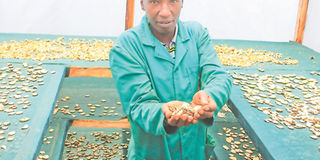Prolong the shelf life of fruits, vegetables using these methods

A food technologist spreads out a variety of products to dry inside a solar dryer at the Wambugu Agricultural Training Centre in Nyeri in this past photo. Besides extending the shelf life of the produce, drying reduces bulkiness and weight, easing storage and transportation. PHOTO | FILE | NATION MEDIA GTOUP
What you need to know:
- To begin with, most vegetables are seasonal and highly perishable, and thus start losing their colour, taste and quality soon after harvest. If not preserved, they wilt and finally rot.
- A simple home-made solar dryer is made of wood and (black) plastic material that absorbs sunlight, slowly drying sliced fruits and vegetables to curb spoilage.
- For fruits, which are not overly ripe, they are cleaned, sliced thinly and placed in some warm water containing anti-browning substance for some minutes.
- For onions to be preserved for months, they need to be stored in a dry area where temperatures stay between 30 to 50 degrees Celsius.
With several food markets closed amid greater restriction on the movement of people to curb the spread of the new coronavirus, supply of fruits and vegetables is getting scarcer.
Households, therefore, have to learn ways of preserving their food to ensure their supplies run for several days, if not weeks, without the need for refrigeration
To begin with, most vegetables are seasonal and highly perishable, and thus start losing their colour, taste and quality soon after harvest. If not preserved, they wilt and finally rot.
There are several methods one can use to preserve fruits.
Solar drying
Benard Kinoti, a nutritionist and an extension officer in Meru County, says the process of preserving vegetables and fruits should start with cleaning them thoroughly.
A simple home-made solar dryer is made of wood and (black) plastic material that absorbs sunlight, slowly drying sliced fruits and vegetables to curb spoilage.
Besides extending the shelf life of the produce, drying reduces bulkiness and weight, easing storage and transportation.
Blanching
Blanching is a cooking technique that entails briefly immersing the food in steam or in boiling water. This is then followed by ‘shocking’ the vegetables by plunging them in cold running water.
Blanching helps halt enzyme actions thus preserving the colour, and retaining the flavour, quality and nutrients.
Placing the vegetables in cold water helps in stopping the cooking that had been initiated during blanching. Kinoti warns that if one dries the vegetables without maintaining the conditions, the vegetables will go bad or rot and no nutrients will be retrained. Once blanched, dry them in a shade and pack in containers and store in a cool, dry place.
Sun drying
Victor Marangu, a nutrition officer who worked with USAid in Tharaka constituency, says before sun-drying vegetables, they must be washed with clean water, sliced into pieces and placed in hot water for 2-5 minutes to help them retain the green colour when sun-dried.
The vegetables are then drained and spread thinly on a clean black polythene sheet placed on a raised platform in full sun until they are very dry and crack easily.
For fruits, which are not overly ripe, they are cleaned, sliced thinly and placed in some warm water containing anti-browning substance for some minutes.
Thereafter, they are placed on a clean black polythene sheet and placed in full sun. As vegetables, they should be covered to keep off flies, and birds.
This method allows one to keep fruits for up to six months. To store them, package in an airtight moisture-proof black plastic bag, while avoiding damage from sun light.
During drying, several factors play a key role, among them, the prevailing weather conditions, the produce size and shape, thickness of the layer, turning intervals and initial moisture content.
Pumpkins can last up to four months and sweet potatoes one month if stored in a cool dark place. The shelf life of cabbages can be extended if they are wrapped in plastic and stored in the refrigerator for up to two months.
For onions to be preserved for months, they need to be stored in a dry area where temperatures stay between 30 to 50 degrees Celsius.
Dried vegetables such as spinach, sukuma wiki and cabbages are refreshed by putting them in hot water and simmering to required tenderness.
Root, stem and seed vegetables are soaked for 30 minutes for an hour and half in enough cold water and then cooked.





